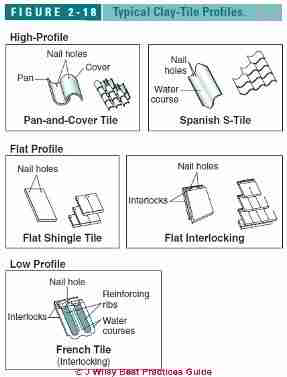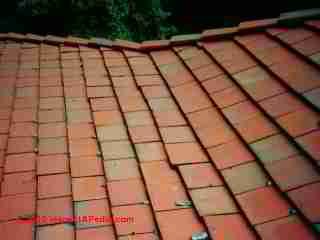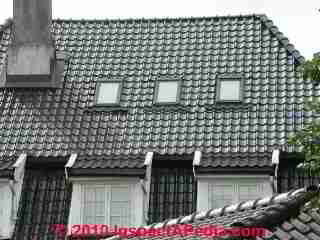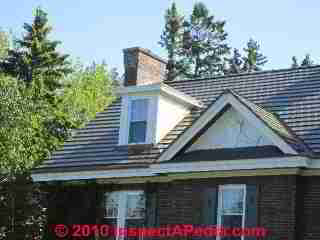 Guide to Clay Tile Roof Styles, Shapes, Profiles, Uses
Guide to Clay Tile Roof Styles, Shapes, Profiles, Uses
Photo Guide to clay roofing tile shapes
- POST a QUESTION or COMMENT about choices of clay tile roof styles, types, designs
Guide to clay roofing tile styles and shapes: this article explains the different styles, profiles, and characteristics of clay tile roofing tiles.
Our page top photo shows clay roofing tiles installed in Boca Raton, Florida. On this Florida roof the tiles provide cosmetic appearance and sun protection but on this roof, not waterproofing.
This Boca Raton roof relies on a waterproof membrane below the clay tiles to keep water out of the building. This article series explains clay tile roofing types, clay roofing tile inspection, tile roofing diagnosis, & tile roof repair.
InspectAPedia tolerates no conflicts of interest. We have no relationship with advertisers, products, or services discussed at this website.
- Daniel Friedman, Publisher/Editor/Author - See WHO ARE WE?
Clay Roofing Tile Styles & Profiles

Clay roof tiles are available in traditional two-piece styles, one-piece profiles, and flat profiles (Figure 2-18).
Clay tile designs are either overlapping or interlocking, with protruding lips that lock the tiles together and form a weather seal.
Many flat clay tiles interlock. Interlocking designs are recommended for regions with heavy rain or snow. Manufacturers provide special trim tiles to seal the voids formed at ridges, rakes, and hips.
Pan and Cover Style Clay Roof Tiles
This traditional two-piece style, also called barrel- or Mission-style clay tile, is installed in pairs with the cover tile overlapping the pan tile. It provides an attractive high-profile look but is labor-intensive and expensive to install.
Variations include Roman and Greek profiles, which have flat, rather than curved, pan tiles. Tiles typically range from 8 to 12 inches in width and from 16 to 19 inches long.
Spanish S-tile Clay Roofing Tiles
Spanish S-tiles used on roofs are one-piece tiles provide the high-profile look of traditional pan-and-cover tile but with simpler installation. The most popular S-tiles measure about 13 inches wide by 16 1/2 inches long. Other common sizes are 8 3/4 x11 and 9 x14 inches.
Flat Shingle Style Clay Roof Tiles
Flat shingle style clay roofing tiles are laid in a double thickness, like slate. These clay roof tile widths range from 6 to 8 inches, lengths from 12 to 18 inches.
Interlocking Clay Roofing Tiles©

Interlocking clay roof tiles (photo at left) are either flat or low profile and are laid in a single thickness with a 3-inch overlap.
They have interlocks on the sides with channels or ribs, and butts may also lock into the tops of the underlying shingles. Contours and ribs add strength to the tiles.
Widths typically range from 9 to 13 inches and lengths from 11 to 16 inches.
Additional photographs of types of clay roof tiles can be found at CLAY TILE ROOFING.
Choices of Clay Roof Tiles for Freezing Climates
The two glazed roof tiles shown below were on homes in freezing climates of Norway (below left) and Duluth, MN (below right). Best Practices Guide to Residential Construction points out that
To make tiles, moist clay is extruded through a die or cast in a mold and then fired in a kiln until the clay “vitrifies,” fusing the particles together. Complete vitrification will create a strong tile with very low water absorption, which protects tile from freeze-thaw damage in cold climates or damage from salt air in coastal areas.
Watch out: Where regular freeze-thaw cycling is expected, roof tiles should comply with ASTM C1167 Grade 1, which allows minimal water absorption. Grade II tile provides moderate resistance to frost action, and Grade III tile is porous and should not be used in freeze-thaw areas.
When buying clay tile, look for at least a 50-year warranty on both durability and fading. Costs vary widely, depending on quality, style, and the shipping distance required. In general, patterns using smaller tiles will cost more for both materials and labor.


Clay Roofing Tile Color Choices
 Clay roofing tiles come in a wide range of colors. Color-through
tile takes the natural color of the clay, ranging
from light tan to pink and red.
Clay roofing tiles come in a wide range of colors. Color-through
tile takes the natural color of the clay, ranging
from light tan to pink and red.
Our clay roof tile photo (left) shows that a repair tile has been inserted and does not match the original roof in color or texture. This roof had other broken tiles (and leaks) apparently from foot traffic.
Other colors can be added to the tile surface as a clay slurry before firing, but slurry coatings are only suitable for warm climates, as they cannot withstand freeze-thaw cycles.
Clay tile can also be colored with ceramic glazes [see our photographs just above] to create a durable, glass-like surface in just about any color.
In general, clay tiles do not fade in the sun. [Above we discussed selection of clay roofing tiles for freezing climates].
Blended Clay Roof Tile Patterns
Some jobs require the installer to mix two or three different colors in a random pattern. The best way to achieve this is to premix bundles on the ground with the correct proportion of each color, then send them up to the roof for installation. Periodically inspect the roof from the ground for hot spots or streaking.
Clay Roof Tile Sources & Manufacturers
Best Practices Guide to Residential Construction [at REFERENCES] lists these producers and sources of clay roofing tiles, roof tile fastening systems, and related clay roofing products
- Altusa, Clay Forever LLC, website: www.altusa.com
- Ludowici Roof Tile, website: www.ludowici.com
- MCA Clay Tile, website: www.mca-tile.com
- U.S. Tile Co., website: www.ustile.com
Clay Roofing Tile Fasteners & Adhesives - Sources & Manufacturers
- Dow Building Products, website:
www.dow.com/buildingproducts
Tile Bond polyurethane foam tile adhesive - Fomo Products, website:
www.fomo.com
Handi-Stick polyurethane foam tile adhesive - Newport Fastener, website:
www.newportfastener.com
Twisted wire systems, hurricane clips, nose clips,
and the Tyle-Tye TileNail - OSI Sealants, website:
www.osisealants.com
RT 600 synthetic rubber tile adhesive - Polyfoam Products, website:
www.polyfoam.cc
Polyset and Polyset One polyurethane foam
tile adhesives - Wire works, Inc., website:
www.wireworks-inc.com
Tile hooks, hook nails, copper and stainless-steel nails
- - Adapted with permission from Best Practices Guide to Residential Construction (Steve Bliss, J Wiley & Sons) .
This article includes excerpts or adaptations from Best Practices Guide to Residential Construction (Steve Bliss, J Wiley & Sons) , by Steven Bliss, courtesy of Wiley & Sons.
...
Continue reading at CLAY, CONCRETE, FIBER CEMENT ROOF TILE CHOICES or select a topic from the closely-related articles below, or see the complete ARTICLE INDEX.
Or see these
Recommended Articles
- CLAY TILE ROOFING - home
- CLAY TILE ROOF BATTENS & STACKING
- CLAY TILE ROOF CONNECTIONS
- CLAY TILE ROOF DAMAGE & WEAR
- CLAY TILE EAVES, HIP & RAKE DETAILS
- CLAY TILE ROOF FLASHING
- CLAY TILE ROOF FLASHING LEAKS
- CLAY TILE ROOF SLOPE, DECK & UNDERLAY
- CLAY TILE ROOF SPECIFICATIONS
- CLAY TILE ROOF SUPPLIERS
- CLAY TILE ROOF STYLES, DESIGNS
- CLAY TILE WIND & SEISMIC CONNECTORS
- CLAY, CONCRETE, FIBER CEMENT ROOF TILE CHOICES
- DURALITA & METAL TILE ROOFS
Suggested citation for this web page
CLAY TILE ROOF STYLES, DESIGNS at InspectApedia.com - online encyclopedia of building & environmental inspection, testing, diagnosis, repair, & problem prevention advice.
Or see this
INDEX to RELATED ARTICLES: ARTICLE INDEX to BUILDING ROOFING
Or use the SEARCH BOX found below to Ask a Question or Search InspectApedia
Ask a Question or Search InspectApedia
Questions & answers or comments about different styles, shapes, & profiles of clay roofing tiles & their applications..
Try the search box just below, or if you prefer, post a question or comment in the Comments box below and we will respond promptly.
Search the InspectApedia website
Note: appearance of your Comment below may be delayed: if your comment contains an image, photograph, web link, or text that looks to the software as if it might be a web link, your posting will appear after it has been approved by a moderator. Apologies for the delay.
Only one image can be added per comment but you can post as many comments, and therefore images, as you like.
You will not receive a notification when a response to your question has been posted.
Please bookmark this page to make it easy for you to check back for our response.
IF above you see "Comment Form is loading comments..." then COMMENT BOX - countable.ca / bawkbox.com IS NOT WORKING.
In any case you are welcome to send an email directly to us at InspectApedia.com at editor@inspectApedia.com
We'll reply to you directly. Please help us help you by noting, in your email, the URL of the InspectApedia page where you wanted to comment.
Citations & References
In addition to any citations in the article above, a full list is available on request.
- Steve Bliss's Building Advisor at buildingadvisor.com helps homeowners & contractors plan & complete successful building & remodeling projects: buying land, site work, building design, cost estimating, materials & components, & project management through complete construction. Email: info@buildingadvisor.com
Steven Bliss served as editorial director and co-publisher of The Journal of Light Construction for 16 years and previously as building technology editor for Progressive Builder and Solar Age magazines. He worked in the building trades as a carpenter and design/build contractor for more than ten years and holds a masters degree from the Harvard Graduate School of Education. Excerpts from his recent book, Best Practices Guide to Residential Construction, Wiley (November 18, 2005) ISBN-10: 0471648361, ISBN-13: 978-0471648369, appear throughout this website, with permission and courtesy of Wiley & Sons. Best Practices Guide is available from the publisher, J. Wiley & Sons, and also at Amazon.com - Mark Cramer Inspection Services Mark Cramer, Tampa Florida, Mr. Cramer is a past president of ASHI, the American Society of Home Inspectors and is a Florida home inspector and home inspection educator. Mr. Cramer serves on the ASHI Home Inspection Standards. Contact Mark Cramer at: 727-595-4211 mark@BestTampaInspector.com
- John Cranor [Website: /www.house-whisperer.com ] is an ASHI member and a home inspector (The House Whisperer) is located in Glen Allen, VA 23060. He is also a contributor to InspectApedia.com in several technical areas such as plumbing and appliances (dryer vents). Contact Mr. Cranor at 804-873-8534 or by Email: johncranor@verizon.net
- The Carson Dunlop home study course for home inspectors can be examined at the company's website at https://www.carsondunlop.com/training/us/
- Duralita: produces cement & cardboard corrugated and clay tile-like roofing products: Duralita is a combination of cement and cardboard - see www.duralita.com/ Si tiene alguna pregunta, por favor escribanos a: sales@duralita.com - El Salvador: +503 22.25.57.44 ext.31 USA +1 305.677.3597
- Terry Rubin, proprietor of the Posada del Bosque Encantado can be contacted at gringamaya@yahoo.com or call (502) 5208-5334 or (502) 4146-1050 use 011 (502) from the US.
- "Tile Roofs in Snow Country: The Natural Choice For Aesthetics and Durability Proper planning and installation ensure a tile roof with elegance, durability, and low maintenance for premier resort in Vail, Colorado", Mark Wennstedt, Source Products Group, 303 280-9595 - Web Search 07/12/2010 - Original Source http://pdfone.com/download/12_keyword-roof-shingles/tile-roofs-in-snow-country.pdf
- Decks and Porches, the JLC Guide to, Best Practices for Outdoor Spaces, Steve Bliss (Editor), The Journal of Light Construction, Williston VT, 2010 ISBN 10: 1-928580-42-4, ISBN 13: 978-1-928580-42-3, available from Amazon.com
- Roof Tiling & Slating, a Practical Guide, Kevin Taylor, Crowood Press (2008), ISBN 978-1847970237,
If you have never fixed a roof tile or slate before but have wondered how to go about repairing or replacing them, then this is the book for you. Many of the technical books about roof tiling and slating are rather vague and conveniently ignore some of the trickier problems and how they can be resolved. In Roof Tiling and Slating, the author rejects this cautious approach. Kevin Taylor uses both his extensive knowledge of the trade and his ability to explain the subject in easily understandable terms, to demonstrate how to carry out the work safely to a high standard, using tried and tested methods.
This clay roof tile guide considers the various types of tiles, slates, and roofing materials on the market as well as their uses, how to estimate the required quantities, and where to buy them. It also discusses how to check and assess a roof and how to identify and rectify problems; describes how to efficiently "set out" roofs from small, simple jobs to larger and more complicated projects, thus making the work quicker, simpler, and neater; examines the correct and the incorrect ways of installing background materials such as underlay, battens, and valley liners; explains how to install interlocking tiles, plain tiles, and artificial and natural slates; covers both modern and traditional methods and skills, including cutting materials by hand without the assistance of power tools; and provides invaluable guidance on repairs and maintenance issues, and highlights common mistakes and how they can be avoided. The author, Kevin Taylor, works for the National Federation of Roofing Contractors as a technical manager presenting technical advice and providing education and training for young roofers. - History of the Concrete Roofing Tile, Batsford, 1959, AISN B000HLLOUC (available used)
- In addition to citations & references found in this article, see the research citations given at the end of the related articles found at our suggested
CONTINUE READING or RECOMMENDED ARTICLES.
- Carson, Dunlop & Associates Ltd., 120 Carlton Street Suite 407, Toronto ON M5A 4K2. Tel: (416) 964-9415 1-800-268-7070 Email: info@carsondunlop.com. Alan Carson is a past president of ASHI, the American Society of Home Inspectors.
Thanks to Alan Carson and Bob Dunlop, for permission for InspectAPedia to use text excerpts from The HOME REFERENCE BOOK - the Encyclopedia of Homes and to use illustrations from The ILLUSTRATED HOME .
Carson Dunlop Associates provides extensive home inspection education and report writing material. In gratitude we provide links to tsome Carson Dunlop Associates products and services.

